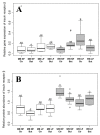Modulation of Hepatic Insulin and Glucagon Signaling by Nutritional Factors in Broiler Chicken
- PMID: 35324832
- PMCID: PMC8955576
- DOI: 10.3390/vetsci9030103
Modulation of Hepatic Insulin and Glucagon Signaling by Nutritional Factors in Broiler Chicken
Abstract
Influencing the endocrine metabolic regulation of chickens by nutritional factors might provide novel possibilities for improving animal health and productivity. This study was designed to evaluate the impact of dietary cereal type (wheat-based (WB) vs. maize-based (MB) diets), crude protein level (normal (NP) vs. lowered (LP)), and sodium (n-)butyrate (1.5 g/kg diet) supplementation (vs. no butyrate) on the responsiveness of hepatic glucagon receptor (GCGR), insulin receptor beta (IRβ) and mammalian target of rapamycin (mTOR) in the phase of intensive growth of chickens. Liver samples of Ross 308 broiler chickens (Gallus gallus domesticus) were collected on day 21 for quantitative real-time polymerase chain reaction and Western blot analyses. Hepatic GCGR and mTOR gene expressions were up-regulated by WB and LP diet. GCGR and IRβ protein level decreased in groups with butyrate supplementation; however, the quantity of IRβ and mTOR protein increased in WB groups. Based on these data, the applied dietary strategies may be useful tools to modulate hepatic insulin and glucagon signaling of chickens in the period of intensive growth. The obtained results might contribute to the better understanding of glycemic control of birds and increase the opportunity of ameliorating insulin sensitivity, hence, improving the production parameters and the welfare of broilers.
Keywords: butyrate; chicken; glucagon; hepatic glucagon receptor; insulin; insulin receptor beta; mammalian target of rapamycin; non-starch polysaccharides.
Conflict of interest statement
The authors declare no conflict of interest. The funders had no role in the design of the study; in the collection, analyses, or interpretation of data; in the writing of the manuscript, or in the decision to publish the results.
Figures





Similar articles
-
Effects of butyrate on the insulin homeostasis of chickens kept on maize- or wheat-based diets.Acta Vet Hung. 2016 Dec;64(4):482-496. doi: 10.1556/004.2016.045. Acta Vet Hung. 2016. PMID: 27993103 Clinical Trial.
-
Effect of dietary cereal type, crude protein and butyrate supplementation on metabolic parameters of broilers.Acta Vet Hung. 2018 Sep;66(3):408-452. doi: 10.1556/004.2018.037. Acta Vet Hung. 2018. PMID: 30264622
-
Effects of oral butyrate application on insulin signaling in various tissues of chickens.Domest Anim Endocrinol. 2015 Jan;50:26-31. doi: 10.1016/j.domaniend.2014.07.004. Epub 2014 Aug 7. Domest Anim Endocrinol. 2015. PMID: 25240231 Clinical Trial.
-
Effects of dietary butyrate supplementation and crude protein level on carcass traits and meat composition of broiler chickens.Arch Anim Breed. 2019 Sep 2;62(2):527-536. doi: 10.5194/aab-62-527-2019. eCollection 2019. Arch Anim Breed. 2019. PMID: 31807664 Free PMC article.
-
Caeca Microbial Variation in Broiler Chickens as a Result of Dietary Combinations Using Two Cereal Types, Supplementation of Crude Protein and Sodium Butyrate.Front Microbiol. 2021 Jan 11;11:617800. doi: 10.3389/fmicb.2020.617800. eCollection 2020. Front Microbiol. 2021. PMID: 33505386 Free PMC article.
Cited by
-
A perception that the feed grain basis of reduced-crude protein diets modifies the anabolic impact of insulin on the growth performance of broiler chickens.Anim Nutr. 2025 Mar 27;21:245-255. doi: 10.1016/j.aninu.2024.10.009. eCollection 2025 Jun. Anim Nutr. 2025. PMID: 40487105 Free PMC article. Review.
-
Different starch sources and amino acid levels on growth performance, starch and amino acids digestion, absorption and metabolism of 0- to 3-week-old broilers fed low protein diet.Anim Nutr. 2024 Nov 28;20:277-290. doi: 10.1016/j.aninu.2024.11.004. eCollection 2025 Mar. Anim Nutr. 2024. PMID: 39995521 Free PMC article.
References
-
- Chamba F., Puyalto M., Ortiz A., Torrealba H., Mallo J.J., Riboty R. Effect of partially protected sodium butyrate on performance, digestive organs, intestinal villi and E. coli development in broilers chickens. Int. J. Poult. Sci. 2014;13:390–396. doi: 10.3923/ijps.2014.390.396. - DOI
-
- Svihus B., Choct M., Classen H.L. Function and nutritional roles of the avian caeca: A review. World’s Poult. Sci. J. 2013;69:249–263. doi: 10.1017/S0043933913000287. - DOI
Grants and funding
LinkOut - more resources
Full Text Sources
Miscellaneous

